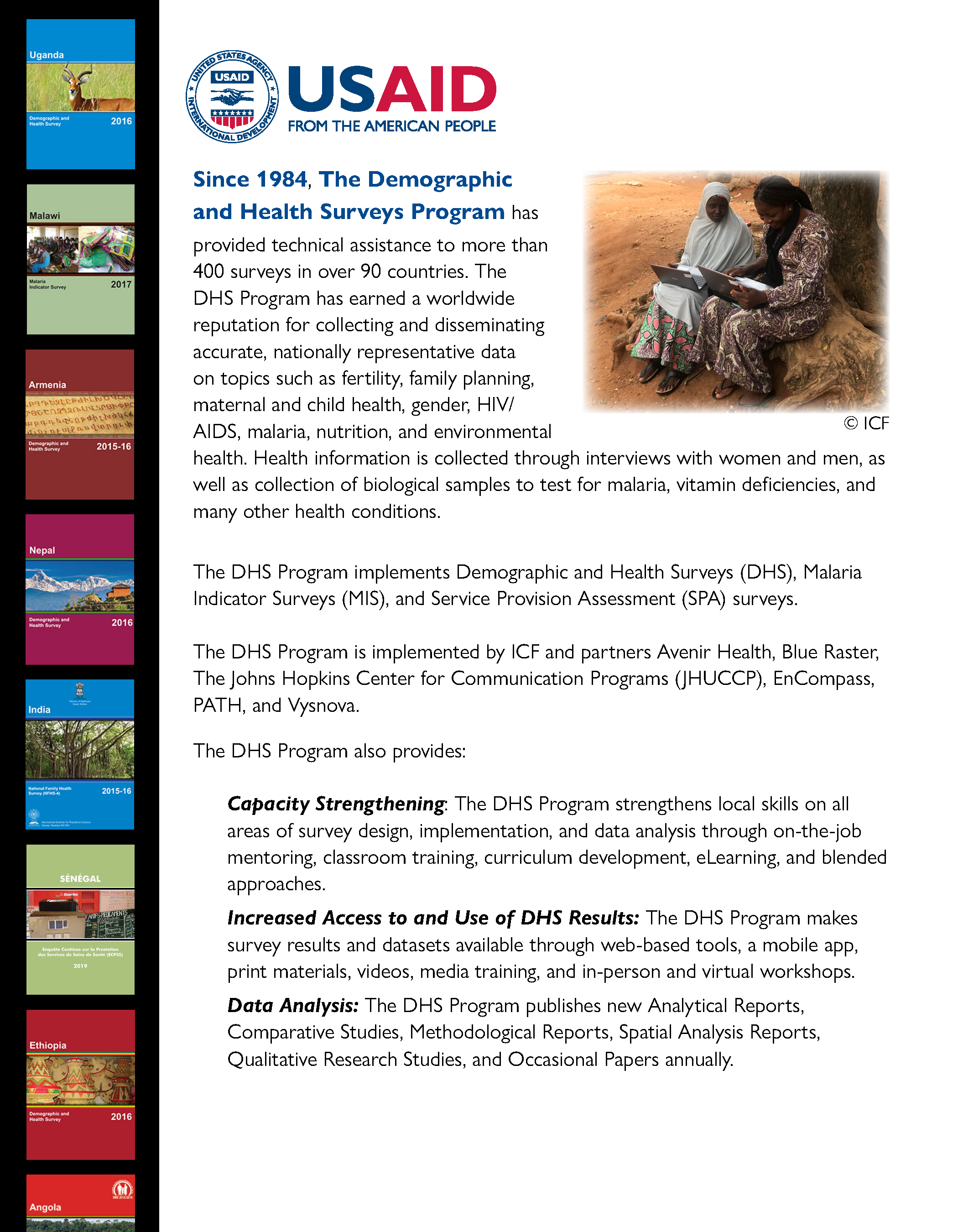Press Releases
New country reports highlight global health inequalities
Calverton, MD - Health care initiatives throughout the developing world should make greater efforts to reach the world's poor, suggests a new series of reports highlighting health inequalities in 56 low-income and middle-income countries. Worldwide, the health of the poor is notably worse than that of the better-off. On average, the poorest suffer under-five mortality and malnutrition rates that are about twice as much as the best-off. In some countries the difference is much greater. In Egypt, for example, children living in the poorest households are nearly three times as likely to die before age five as children in the best-off households. In South Africa, they are four times as likely to die early.
The 56 country reports are a joint effort of the Demographic and Health Surveys (DHS) project and the World Bank. They are based on data drawn from 95 household DHS surveys conducted between 1990 and 2005. The series is called Socio-Economic Differences in Health, Nutrition, and Population (The World Bank, 2007).
The findings also indicate that the poor use health services less, have less adequate health-related behaviors, and are disadvantaged with respect to other determinants of health status. Within countries, the poor are less likely than the better off to receive adequate health care. Levels of antenatal care, immunization, and school participation all decrease as the level of household wealth declines. In South Asia, for example, just 13 percent of the poorest women receive antenatal care from a doctor compared with 66 percent of the best-off women, a five-fold difference.
The report series also includes a new overview report, Socio-Economic Differences in Health, Nutrition, and Population Within Developing Countries: An Overview. More than 100 different health indicators are presented covering four broad categories - health status, use of basic health services, health-related behaviors (such as smoking and sexual behavior), and other issues related to health status, such as education. Economic status was determined by collecting information on households' ownership of basic assets, durable goods and availability of household services to measure living standard and then to divide the population into economically-defined quintiles (20 percent groupings).
The overview report will be officially launched on Monday, February 25th at the World Bank J-Building, Auditorium J1-050 from 12:00 - 2:00 pm. Authors Shea Rutstein of DHS, Davidson Gwatkin, and Adam Wagstaff will discuss their findings. For more information, please go to http://www.worldbank.org/hnp The event is free and open to the public. Please RSVP to infoShopevents@worldbank.org.
The country reports also feature estimates for each economically defined 20 percent (quintile) of the population. The estimates cover up to approximately 120 indicators of health status, service use, behavior, or health-related social development. In addition, each country report contains: separate estimates for males and females and for rural and urban residents within the wealth quintiles; a presentation and discussion of the methods used in preparing the tables; links to other sources of health inequality data; and guidance on using material in the report to monitor how well health projects reach disadvantaged population groups.
The data presented in the overview report are the same as those appearing in the sections of the individual country reports that deal with the countries' total population, but they are organized by indicator to facilitate cross-country comparisons and the identification of global patterns. The overview and countries reports were written by Davidson R. Gwatkin, Shea Rutstein, Kiersten Johnson, Eldaw Suliman, Adam Wagstaff, and Agbessi Amouzou.
Hard copies may be obtained upon request from the World Bank's health and population resource center: healthpop@worldbank.org
Country Reports are available for:
- East Asia and the Pacific: Cambodia, Indonesia, the Philippines, Vietnam
- Europe and Central Asia: Armenia, Kazakhstan, Kyrgyz Republic, Turkey, Turkmenistan, Uzbekistán
- Latin America and the Caribbean: Bolivia, Brazil, Colombia, Dominican Republic, Guatemala, Haiti, Nicaragua, Paraguay, Peru
- Middle East and North Africa: Egypt, Jordan, Morocco, Yemen
- South Asia: Bangladesh, India, Nepal, Pakistan
- Sub-Saharan Africa: Benin, Burkina Faso, Cameroon, Central African Republic, Chad, Comoros, Côte d'Ivoire, Eritrea, Ethiopia, Gabon, Ghana, Guinea, Kenya, Madagascar, Malawi, Mali, Mauritania, Mozambique, Namibia, Niger, Nigeria, Rwanda, Senegal, South Africa, Tanzania, Togo, Uganda, Zambia, Zimbabwe
Topics Covered in Reports:
The number of topics covered varies from country to country, depending upon the contents of the country's Demographic and Health Survey. Among the topics included in most country reports are:
- Health Status: Infant and Under-Five Mortality; Childhood Fever, Diarrhea, and Acute Respiratory Infection; Total and Adolescent Fertility; Stunting and Underweight among Children; Undernutrition among Women.
- Health Service Use: Childhood Immunization; Treatment of Childhood Fever, Diarrhea, and Acute Respiratory Infection; Antenatal Care and Delivery Attendance; Contraceptive Use.
- Individual and Household Behavior: Breastfeeding. (Additional Topics Covered in Some Countries Include Bednet Ownership and Use, Tobacco and Alcohol Use, Sexual Practices, and Domestic Violence.)
- Underlying Determinants: Education; Exposure to Mass Media; Status of Women
